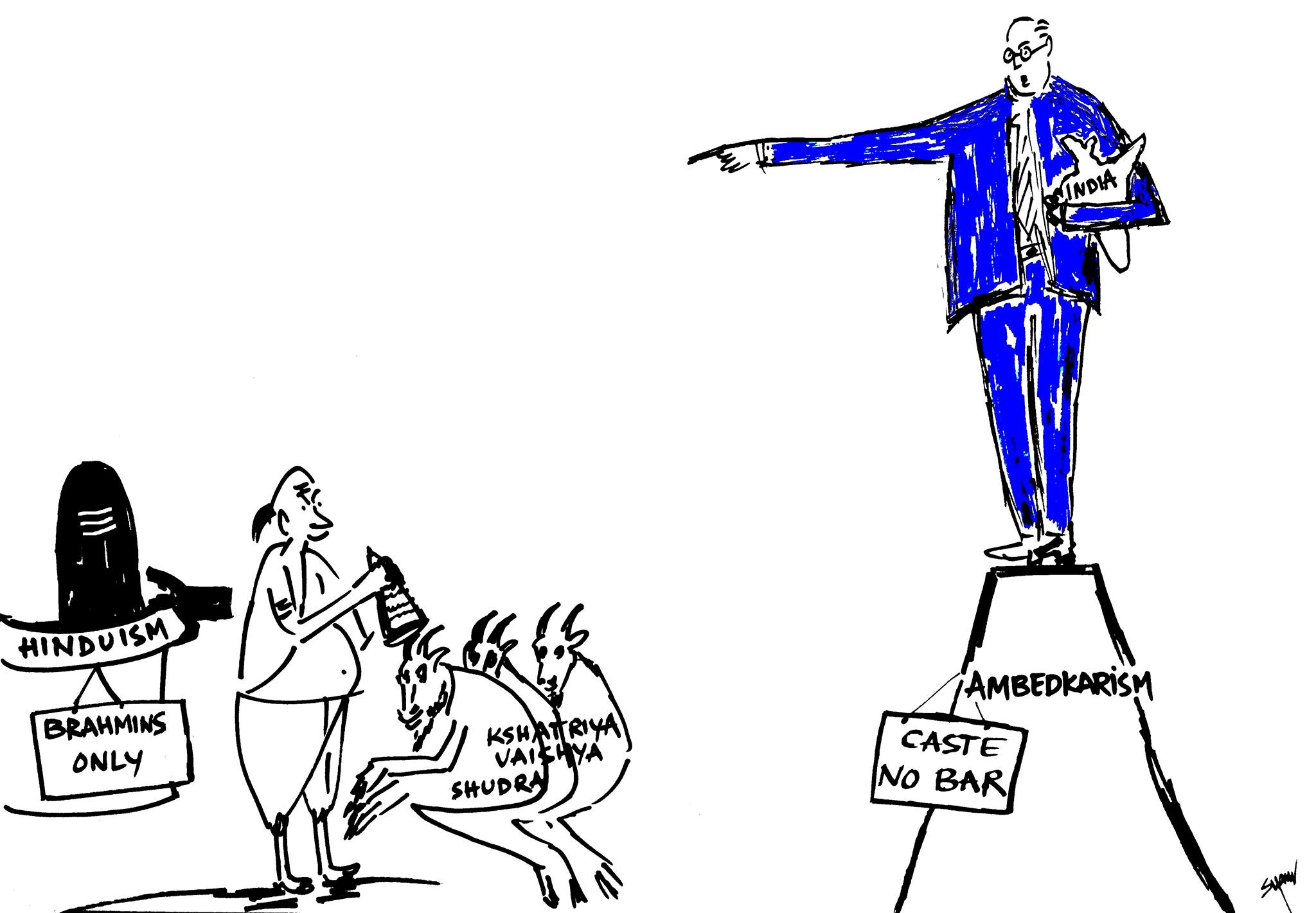Yogesh Maitreya
 I had started to read texts on Buddhism during my four years at one of the Buddhist orders. It was first conceptualised in a western country, i.e., England, and then started its operation in India in the late 1980s. I read several texts. I found the classical ones to be unclear but I found the contemporary ones, which were the interpretations of Buddhism by contemporary writers like Dr. Ambedkar and Sangharkshita, logical enough to understand their relevance in day to day life.
I had started to read texts on Buddhism during my four years at one of the Buddhist orders. It was first conceptualised in a western country, i.e., England, and then started its operation in India in the late 1980s. I read several texts. I found the classical ones to be unclear but I found the contemporary ones, which were the interpretations of Buddhism by contemporary writers like Dr. Ambedkar and Sangharkshita, logical enough to understand their relevance in day to day life.
However, Ambedkar’s revival of Buddhism had already made it quite clear what it means to be a Buddhist in today’s caste-ridden India. In short, Ambedkar’s Buddhism was an anti-caste way of life and struggle, not metaphysical rambling. In propounding the twenty two vows, Ambedkar rejected all Hindu gods, none of them were to be idolized. There was a profound logic behind his statement that was constituted from an in-depth analysis of the historical struggle and empirical knowledge of the clashes between Buddhism and Brahmanism.
But as I gave myself a chance to read and develop critical thinking on the different schools of Buddhism, I found Tibetan Buddhism, particularly in India, the most problematic way of preaching the teachings of the Buddha in the contemporary context of Indian society. Since this article focuses on the Tibetan approach to Buddhism within and among dalits in India, I would like to begin by pointing towards how the Dalai Lama, as I have observed over some time, projects Ambedkar. On none of the occasions on which the Dalai Lama refers to Ambedkar does he find it necessary to elaborate on the Buddhist imperatives behind Ambedkar’s anti-caste movement and his interpretation of Buddhism within this caste society and the need to annihilate the notion of caste. And all the references to Ambedkar are made within the spaces where he is already known.
About four years back, the Dalai Lama started referring to Ambedkar saying that ‘Dr. Ambedkar, the creator of the Indian Constitution, spread awareness about the religion in 1956. Today, we need to understand the real meaning of Buddha, Buddhism’. Now this statement itself carries some hints that undermine Ambedkar’s contribution to one of the largest struggles humanity has seen and his most radical and comprehensive interpretation of Buddhism (including Buddhism as the anti-caste movement’s imperative) which Dalai Lama never seems to admire or project.
Also it wasn’t the religion alone that Ambedkar had embraced; it was dhamma, indeed sadhamma, that he had revived. At the same function Dalai Lama had said, ‘All the religions preach the same values of compassion, friendship towards fellow living beings. It is a matter of pride that India is the only country in the world where all the religions coexist in mutual brotherhood’. Those who are aware of Immanuel Kant’s Categorical Imperatives will certainly understand the motive behind this statement. If one studies the historical past of the Dalai Lama in India as a refugee, this statement can be justified considering his need to survive in the country by not criticising the values of the dominant religion, Hinduism, even though it is a religion in which,the lives of dalits are prone to be haunted by inhumane conditions like, for example, the lives of those carrying out the occupation of manual scavenging. This statement also suggests the deliberate negation of the fact of the practice of untouchability under Hinduism, which is still prevalent in India.
How can the same religion which has such practices prevalent in it also be called a religion which teaches values of friendship and compassion? There is an embedded political subconscious element in this statement that misleads people. This is a serious problem for dalits who have converted to Buddhism, and have an inclination towards the Dalai Lama’s metaphysical and ‘pristine’ interpretation of Buddhism. If this is not studied within a critical framework, dalits and Buddhists, and those who consider him as one of the authorities on Buddhism will end up developing an ‘appropriated and manipulated’ version of Buddhism in their minds. This is a serious threat to the counsiousness of anti-caste movement which, in India, survived and strengthened itself after embracing Buddhism in 1956.
I observed some such cases of ‘appropriation and manipulation’ of Dalit consciousness during my four years spent learning Buddhism. I had experienced that this western Buddhist order had mixed many schools of Buddhism like Hinyana, Mahayana and Vajrayana in their syllabus for preaching Buddhism. One of these was the Tibetan tradition of worshipping deities as symbols of human traits such as virtue and compassion. Avalokiteshwara, Padmasambhava, Milarepa, etc., were such Tibetan symbolic personalities to which followers of this particular Buddhist Order prayed to, similar to the manner in which Hindus worship their Gods. The logic behind this, as propagated by the Order, was nothing more than metaphysical explanations. In this entire process, I found such practices as a replacement, if not a replica, of worshiping Hindu gods.
Unfortunately, this Tibetan cult of Buddhism has never been questioned by any of the people who are associated with it on its societal rationales, let alone questioning the Dalai Lama and his apolitically political appeasement of rightwing forces in India. Since Buddhism is the only tradition where God does not exist and it provides scope for human beings to develop their lives on the basis of reason and logic, through discussions and critique, some questions need to be asked: Why critique as a discipline seems to have reached an impasse in the tradition of contemporary Buddhist Orders, both local and those which emerged from western and eastern lands? Are people who belong to or seem to follow Buddhism under their orders becoming apolitical? Or is it that the hierarchy of reverence in these orders wants to maintain itself like an absolute structure? Reflecting over the fact that the Buddha believed in discussion and debate, questioning too, there is something wrong within these spaces.
Since the spiritual structures in contemporary society allow privilege to a few, giving them immunity from participation in labour which the ordinary people of society perform, it creates a certain amount of space in which a parallel structure simultaneously shapes itself towards establishing a hierarchy that rests upon the submissive attitude of lay people who do not question the spiritual personalities. Th dynamics of such spaces determine the projection of theological pedagogy and ‘if the spaces are relatively open, then they would produce different vocabularies, like individualism, civil society, dignity, and self-respect.’ But the spaces I am talking about, have been exhibiting many contradictions, especially in the context of them not having any tradition of critique within, because ‘the privileging of spaces or rendering of spaces as sacred would also produce concepts that acquire a sovereign status. For example, constructing the nationalist space as ‘Mother India’ would make the former sacred and hence beyond any scrutiny and criticism. This construction would treat other vocabularies as hostile to the sovereign vocabularies of self-rule and freedom. Thus, the vocabularies of self-respect and social justice emanating from the dalit perspective would be treated as inimical to such a sacred space.’ (Guru, 2012)
To give an example, when once I mentioned the practice of hero worship among the followers of the Dalai Lama with a female student from Ladakh, who had little awareness of caste and other issues in India as she herself confessed, and is a staunch follower of the Dalai Lama. She felt great humiliation and instead of explaining to me the reality behind staunchly following the Dalai Lama, she came seeking an apology from me. She wanted to listen to no reason and logic behind my interpretation of the views of the Dalai Lama. This is one example from which we could trace how the young minds have been appropriated by the metaphysical ramblings from ‘spiritual authorities’ who are put beyond the scope of questioning.
Now, the fact is that the Dalai Lama’s initiatives as a peace activist have to be appreciated. However, the question of his remaining aloof from criticising and addressing discriminative practices in which RSS is involved in, an organization with which he seemed to share a stage and good rapport on many an occasion, still needs to be addressed. How the Dalai Lama views the politics of RSS, and how he projects the Tibetan teaching among Buddhists in India is important because looking at their socio-economic conditions it seems impossible that the metaphysics of the ritualistic approach of Tibetan Buddhism could deal with with their issues.
In a program at the RSS Smruti Mandir premises, the Dalai Lama was found saying, ‘RSS has always supported the cause of Tibet and hence I always had love for it, RSS thinks not just for India but for the entire world’. What does this statement indicate? What is the imperative and political subconscious behind it? Clearly these views expressed by the Dalai Lama are not only problematic, they are antithetical to Ambedkar’s extensive study of the history of India and his vision behind reviving Buddhism after its disappearance for centuries, his efforts to create a movement intended to create equal and just circumstances by annihilating caste.
Ambedkar argued that, ‘it must be recognised that there has never been something like a common Indian culture, that historically there have been three Indias, Brahminic India, Buddhist India, and Hindu India, each with its own culture. Secondly, it must be recognised that the history of India before the Muslim invasion is the mortal conflict between Bramhanism and Buddhism’. (B.R.Ambedkar, Revolution and Counter Revolution in Ancient India, 2008)
By 1950, Ambedkar redefined the logic of Buddhism in India saying, ‘History of India reveals that after the emergence of Buddhism, Shudras are seen getting thrones. Verily, Buddhism paved way for establishment of democracy and socialistic pattern of society in India’. (B.R.Ambedkar, Buddhism paved way for establishment of democracy and socialistic pattern of society, 2003)
Both the above explanations by Ambedkar evoke the idea that the revival of Buddhism in India in modern time has political and socialist motives which tend to work towards a society based on equality, liberty and justice. But more so, Ambedkar’s revival of Buddhism was an attempt to create a cultural spirit which motivates dalits to work towards a casteless society. Since RSS’ history and present reveal its nationalistic reinforcement on hindutva guidelines which undermine the idea of secular India, the Dalai Lama’s associating with them creates a certain amount of confusion among those dalits and Buddhists in India who are politically and socially conscious of caste politics in public affairs.
Is the Dalai Lama immune from criticism in public affairs and the political domain, especially when I have seen his influence over the dalits and Buddhists around me? What does the Dalai Lama’s appeasement of RSS’ ideological basis and appreciating it imply (also in another way ignoring it too)? It certainly distorts the dalit imagination in the cultural domain, something that has been formed by their historical struggle against caste, to resist the caste forces in today’s political scenario.
On a very different note, the question of the cultural identity of Indian Buddhists has been sidelined in the glamorous aura that the Dalai Lama seems to carry around himself. By the end of his life, around 1955, Ambedkar had initiated a cultural wing named Bhartiya Bauddha Mahasabha or Buddhist Society of India. After Ambedkar’s death, the society functioned moderately and is still in existence. It was the first attempt in modern India that an Indian incepted the idea of a Buddhist cultural wing after its centuries long absence in India. Followed by this, there came up many small and big Buddhist orders, Sanghas. But none have been given the symbolic recognition as a Buddhist order in India and outside, especially among the non-dalit Buddhist population. But in the Dalai Lama’s case, it is totally the opposite. And in the age of globalisation, we find the Dalai Lama as the cultural symbol and representative of the version of Buddhism which is promoted not only by RSS but also by western celebrities.
I argue that this is because the Dalai Lama’s religion projects many similarities with Hinduism – be they ritualistic, cultural, or relating to traditions referencing idol worship and mystifying the scriptural tenets of its theological texts. And this can be linked to the downfall of other Buddhist Orders. The existence of Buddhist people in India is rooted in their stand on caste, their involvement in the anti-caste movement, and more importantly, their rejection of the Hindu Gods on the call of Ambedkar, which isn’t the case with the Dalai Lama’s religion.
~
Bibliography
B.R.Ambedkar, D. (2003). Buddhism paved way for establishment of democracy and socialistic pattern of society. Mumbai: Government of Maharashtra.
B.R.Ambedkar, D. (2008). Revolution and Counter Revolution in Ancient India. Mumbai: Government of Maharashtra .
Guru, G. (2012). The Cracked Mirror. Oxford University Press.
~~~
Yogesh says:
My name is Yogesh Maitreya. I am from Nagpur. I am doing my M.A in Criminology and Justice (2013-15) from TISS (Tata Institute of Social Sciences, Mumbai).










